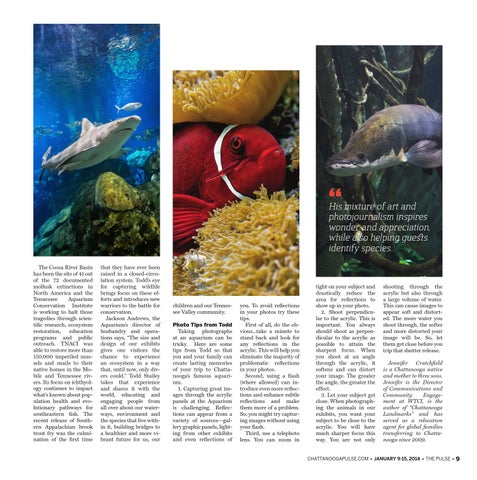“
His mixture of art and photojournalism inspires wonder and appreciation, while also helping guests identify species. The Coosa River Basin has been the site of 41 out of the 72 documented mollusk extinctions in North America and the Tennessee Aquarium Conservation Institute is working to halt those tragedies through scientific research, ecosystem restoration, education programs and public outreach. TNACI was able to restore more than 150,000 imperiled mussels and snails to their native homes in the Mobile and Tennessee rivers. Its focus on ichthyology continues to impact what’s known about population health and evolutionary pathways for southeastern fish. The recent release of Southern Appalachian brook trout fry was the culmination of the first time
that they have ever been raised in a closed-circulation system. Todd’s eye for capturing wildlife brings focus on these efforts and introduces new warriors to the battle for conservation. Jackson Andrews, the Aquarium’s director of husbandry and operations says, “The size and design of our exhibits gives our visitors the chance to experience an ecosystem in a way that, until now, only divers could.” Todd Stailey takes that experience and shares it with the world, educating and engaging people from all over about our waterways, environment and the species that live within it, building bridges to a healthier and more vibrant future for us, our
children and our Tennessee Valley community. Photo Tips from Todd Taking photographs at an aquarium can be tricky. Here are some tips from Todd so that you and your family can create lasting memories of your trip to Chattanooga’s famous aquarium. 1. Capturing great images through the acrylic panels at the Aquarium is challenging. Reflections can appear from a variety of sources—gallery graphic panels, lighting from other exhibits and even reflections of
you. To avoid reflections in your photos try these tips. First of all, do the obvious...take a minute to stand back and look for any reflections in the acrylic. This will help you eliminate the majority of problematic reflections in your photos. Second, using a flash (where allowed) can introduce even more reflections and enhance subtle reflections and make them more of a problem. So, you might try capturing images without using your flash. Third, use a telephoto lens. You can zoom in
tight on your subject and drastically reduce the area for reflections to show up in your photo. 2. Shoot perpendicular to the acrylic. This is important. You always should shoot as perpendicular to the acrylic as possible to attain the sharpest focus. When you shoot at an angle through the acrylic, it softens and can distort your image. The greater the angle, the greater the effect. 3. Let your subject get close. When photographing the animals in our exhibits, you want your subject to be close to the acrylic. You will have much sharper focus this way. You are not only
shooting through the acrylic but also through a large volume of water. This can cause images to appear soft and distorted. The more water you shoot through, the softer and more distorted your image will be. So, let them get close before you trip that shutter release. Jennifer Crutchfield is a Chattanooga native and mother to three sons. Jennifer is the Director of Communications and Community Engagement at WTCI, is the author of “Chattanooga Landmarks” and has served as a relocation agent for global families transferring to Chattanooga since 2009.
chattanoogapulse.com • January 9-15, 2014 • The Pulse • 9
